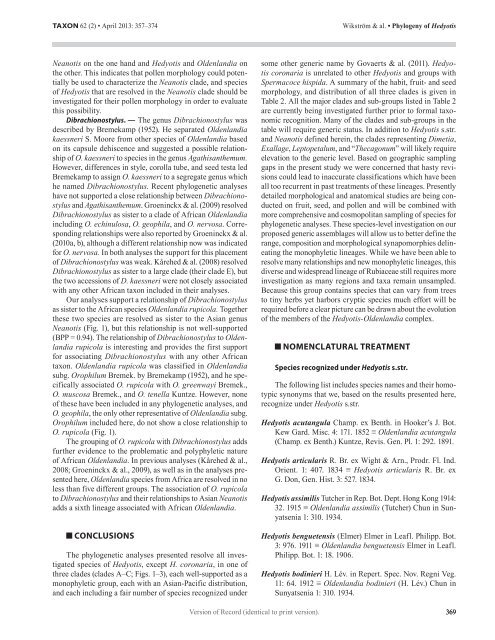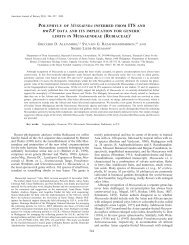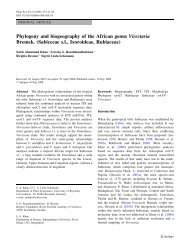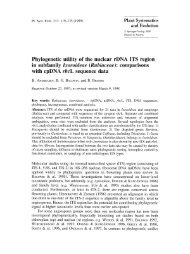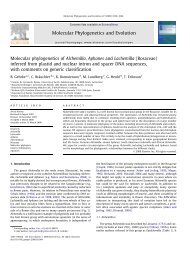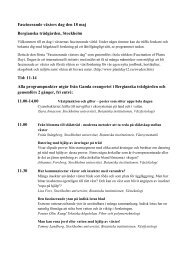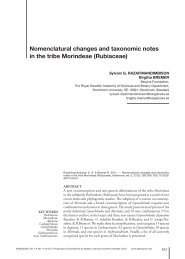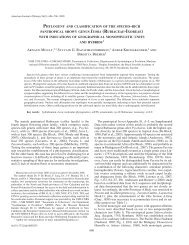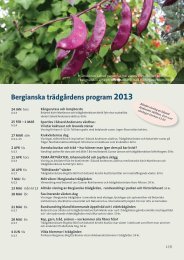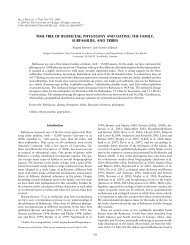Wikström & al. • <strong>Phylogeny</strong> <strong>of</strong> <strong>Hedyotis</strong>TAXON 62 (2) • April 2013: 357–374(<strong>Hedyotis</strong>) auricularia and that do not group with neither<strong>Hedyotis</strong> s.str. nor Oldenlandia s.str. (Fig. 3). Correspondingrelationships were indicated already by Kårehed & al. (2008)who resolved H. capitellata outside <strong>of</strong> <strong>Hedyotis</strong> s.str. and inassociation with several species <strong>of</strong> Oldenlandia (their cladeH). The entire group can, however, not be unequivocally characterizedas having indehiscent fruits. Species such as <strong>Hedyotis</strong>scandens, H. capitellata, H. ampliflora, H. dianxiensis,and Oldenlandia hedyotidea have all been characterized ashaving diplophragmous capsules (Terrell & Robinson, 2003;Chen & Taylor, 2011). These capsular species are resolved asa monophyletic group (“Dimetia” Fig. 3; BPP = 0.99), but despitehaving diplophragmous capsules they were not includedin H. sect. Diplophragma by Lo & al. (1999), who classifiedthem under H. sect. Dimetia. Sister to this group is a wellsupportedgroup (“Exallage” Fig. 3; BPP = 1.00), characterizedby having indehiscent fruits, and with the exception <strong>of</strong> Oldenlandiachrysotricha (Palib.) Chun, all species in this group havepreviously been included under the generic name <strong>of</strong> Exallage.There are some problems in the Exallage/Dimetia cladethat involve the determination <strong>of</strong> specimens included in ouranalyses, and the synonymy <strong>of</strong> species by Govaerts & al. (2011).For example, Govaerts & al. (2011) include H. rigida (Blume)Walp. under the accepted name Oldenlandia cristata (Willd.ex Roem. & Schult.) ined. together with <strong>Hedyotis</strong> vestita R. Br.ex G. Don, <strong>Hedyotis</strong> costata (Roxb.) Kurz, and a large number<strong>of</strong> additional names, and Chen & Taylor (2011) includeH. philippensis (Willd. ex Spreng.) Merr. ex C.B. Rob. as asynonym under H. prostrata Blume. Our analyses do placespecimens determined as <strong>Hedyotis</strong> vestita R. Br. ex G. Don and<strong>Hedyotis</strong> costata (Roxb.) Kurz together, as implied by the synonymy.They are resolved inside the Exallage/Dimetia clade,as suggested by Terrell & Robinson (2003), but they are notclosely related to H. rigida (Blume) Walp.. Also, the specimendetermined as H. philippensis (Willd. ex Spreng.) Merr. exC.B. Rob., as well as the one determined as H. prostrata Blume(determined by C. Taylor), are both placed inside <strong>Hedyotis</strong>s.str., but they are not sister species, as would be expected.Instead, H. philippensis (Willd. ex Spreng.) Merr. ex C.B. Rob.is grouped together with H. rigida (Blume) Walp.Clade C (Neanotis). — The second clade, in which speciespreviously included in <strong>Hedyotis</strong> are resolved, is clade C (Fig. 1).Four species <strong>of</strong> <strong>Hedyotis</strong>, H. trichoclada and H. nana fromNew Guinea, H. pahompokae from Thailand, and H. lindleyanafrom Asia, are resolved together with all included representatives<strong>of</strong> the Asian genus Neanotis. Following the new combinationsmade (see Nomenclatural changes outside <strong>Hedyotis</strong> s.str.below) we will refer to this clade as the genus Neanotis.The generic name Neanotis originates from Lewis (1966)and was adopted as a substitute name for non-American taxapreviously included under the generic name Anotis DC. Reviewingthe taxonomic history <strong>of</strong> Anotis DC., Lewis (1966)noted that taxonomists in the 19th and 20th centuries also includedAsian species from the tribes Hedyotideae (Hooker,1873, 1880) and Oldenlandieae (Schumann, 1891) under thisname. Species included were characterized as herbaceous andwith few and peltate, cymbiform seeds. Going back to theoriginal description <strong>of</strong> Anotis, Lewis noted that all species <strong>of</strong>Anotis (sensu Candolle, 1830) were native to the New Worldand concluded that there was no justification for an inclusion <strong>of</strong>species from Asia. Following the taxonomists <strong>of</strong> the 19th and20th centuries, who had recognized the Asian Anotis as distinctfrom <strong>Hedyotis</strong> or Oldenlandia, he transferred and included theAsian species under the new name Neanotis.Approximately 30 species, distributed in temperate andtropical Asia, are recognized in the genus by Govaerts & al.(2011). They have cymbiform seeds (Schumann, 1891; Lewis,1966), similar to those found in the genus Houstonia (Terrell& Robinson, 2007), and the possibility <strong>of</strong> Neanotis being theclosest non-American relative <strong>of</strong> the Arcytophyllum-Houstoniaclade was discussed briefly by Groeninckx & al. (2009).Our analyses provide strong support for monophyly <strong>of</strong>Neanotis (including the former <strong>Hedyotis</strong> species), but do notindicate a close relationship <strong>of</strong> this group to the Arcytophyllum-Houstonia clade. Sister to Neanotis is a group including twoAfrican species, Dibrachionostylus kaessneri (S. Moore)Bremek. and Oldenlandia rupicola (Sond.) Kuntze (see belowfor a discussion <strong>of</strong> Dibrachionostylus), and together they aresister to a large group in which the Arcytophyllum-Houstoniaclade is nested. However, the relationship to this large group, inwhich the Arcytophyllum-Houstonia clade is nested, is not wellsupported(BPP = 0.94). Sister to the Arcytophyllum-Houstoniaclade is a group comprising two small African genera, MitrasacmopsisJovet (2 spp.) and Hedythyrsus Bremek. (1 sp.), andfour African species <strong>of</strong> Oldenlandia (O. fastigiata Bremek.,O. echinulosa K. Schum., O. geophila Bremek., O. nervosaHiern). This last group corresponds to clade G sensu Kårehed& al. (2008) and relationships in this group, as well as in theArcytophyllum-Houstonia clade were discussed exhaustivelyby them.<strong>Hedyotis</strong> pahompokae was described by Fukuoka (1969)based on collections from Thailand, and is grouped with strongsupport within Neanotis (Fig. 1). Fukuoka (1970), in his “Contributionsto the Flora <strong>of</strong> Southeast Asia”, associated H. phompokaewith <strong>Hedyotis</strong> nalampooni Fukuoka and Oldenlandiakrewanhensis Pierre ex Pit. It is possible that all three speciesshould be transferred to Neanotis, but the relationships<strong>of</strong> H. nelampooni and H. krewanhensis should be confirmedin analyses before such a transfer is completed. Groupedwithin Neanotis are also two species <strong>of</strong> <strong>Hedyotis</strong> from NewGuinea, H. nana and H. trichoclada, both described by Merrill& Perry (1945), who considered them closely allied and readilydistinguished from other species <strong>of</strong> <strong>Hedyotis</strong> by their minuteleaves and prostrate habit. While discussing H. trichoclada,they commented that “although the habit <strong>of</strong> this plant suggestsAnotis, it has all the characters <strong>of</strong> <strong>Hedyotis</strong>”. Contrary to thisview, our analyses strongly support a grouping within Neanotis.<strong>Hedyotis</strong> lindleyana is indicated as a heterotypic synonym toNeanotis hirsuta by Govaerts & al. (2011), and our analysesalso group H. lindleyana (accession collected in Japan) withN. hirsuta from Nepal.Lewis (1966) characterized Neanotis palynologically ashaving brevicolporate pollen with (5)6–12 apertures, and sawa distinct line <strong>of</strong> demarcation in the pollen morphology <strong>of</strong>368 Version <strong>of</strong> Record (identical to print version).
TAXON 62 (2) • April 2013: 357–374Wikström & al. • <strong>Phylogeny</strong> <strong>of</strong> <strong>Hedyotis</strong>Neanotis on the one hand and <strong>Hedyotis</strong> and Oldenlandia onthe other. This indicates that pollen morphology could potentiallybe used to characterize the Neanotis clade, and species<strong>of</strong> <strong>Hedyotis</strong> that are resolved in the Neanotis clade should beinvestigated for their pollen morphology in order to evaluatethis possibility.Dibrachionostylus. — The genus Dibrachionostylus wasdescribed by Bremekamp (1952). He separated Oldenlandiakaessneri S. Moore from other species <strong>of</strong> Oldenlandia basedon its capsule dehiscence and suggested a possible relationship<strong>of</strong> O. kaessneri to species in the genus Agathisanthemum.However, differences in style, corolla tube, and seed testa ledBremekamp to assign O. kaessneri to a segregate genus whichhe named Dibrachionostylus. Recent phylogenetic analyseshave not supported a close relationship between Dibrachionostylusand Agathisanthemum. Groeninckx & al. (2009) resolvedDibrachionostylus as sister to a clade <strong>of</strong> African Oldenlandiaincluding O. echinulosa, O. geophila, and O. nervosa. Correspondingrelationships were also reported by Groeninckx & al.(2010a, b), although a different relationship now was indicatedfor O. nervosa. In both analyses the support for this placement<strong>of</strong> Dibrachionostylus was weak. Kårehed & al. (2008) resolvedDibrachionostylus as sister to a large clade (their clade E), butthe two accessions <strong>of</strong> D. kaessneri were not closely associatedwith any other African taxon included in their analyses.Our analyses support a relationship <strong>of</strong> Dibrachionostylusas sister to the African species Oldenlandia rupicola. Togetherthese two species are resolved as sister to the Asian genusNeanotis (Fig. 1), but this relationship is not well-supported(BPP = 0.94). The relationship <strong>of</strong> Dibrachionostylus to Oldenlandiarupicola is interesting and provides the first supportfor associating Dibrachionostylus with any other Africantaxon. Oldenlandia rupicola was classified in Oldenlandiasubg. Orophilum Bremek. by Bremekamp (1952), and he specificallyassociated O. rupicola with O. greenwayi Bremek.,O. muscosa Bremek., and O. tenella Kuntze. However, none<strong>of</strong> these have been included in any phylogenetic analyses, andO. geophila, the only other representative <strong>of</strong> Oldenlandia subg.Orophilum included here, do not show a close relationship toO. rupicola (Fig. 1).The grouping <strong>of</strong> O. rupicola with Dibrachionostylus addsfurther evidence to the problematic and polyphyletic nature<strong>of</strong> African Oldenlandia. In previous analyses (Kårehed & al.,2008; Groeninckx & al., 2009), as well as in the analyses presentedhere, Oldenlandia species from Africa are resolved in noless than five different groups. The association <strong>of</strong> O. rupicolato Dibrachionostylus and their relationships to Asian Neanotisadds a sixth lineage associated with African Oldenlandia.ConclusionsThe phylogenetic analyses presented resolve all investigatedspecies <strong>of</strong> <strong>Hedyotis</strong>, except H. coronaria, in one <strong>of</strong>three clades (clades A–C; Figs. 1–3), each well-supported as amonophyletic group, each with an Asian-Pacific distribution,and each including a fair number <strong>of</strong> species recognized undersome other generic name by Govaerts & al. (2011). <strong>Hedyotis</strong>coronaria is unrelated to other <strong>Hedyotis</strong> and groups withSpermacoce hispida. A summary <strong>of</strong> the habit, fruit- and seedmorphology, and distribution <strong>of</strong> all three clades is given inTable 2. All the major clades and sub-groups listed in Table 2are currently being investigated further prior to formal taxonomicrecognition. Many <strong>of</strong> the clades and sub-groups in thetable will require generic status. In addition to <strong>Hedyotis</strong> s.str.and Neanotis defined herein, the clades representing Dimetia,Exallage, Leptopetalum, and “Thecagonum” will likely requireelevation to the generic level. Based on geographic samplinggaps in the present study we were concerned that hasty revisionscould lead to inaccurate classifications which have beenall too recurrent in past treatments <strong>of</strong> these lineages. Presentlydetailed morphological and anatomical studies are being conductedon fruit, seed, and pollen and will be combined withmore comprehensive and cosmopolitan sampling <strong>of</strong> species forphylogenetic analyses. These species-level investigation on ourproposed generic assemblages will allow us to better define therange, composition and morphological synapomorphies delineatingthe monophyletic lineages. While we have been able toresolve many relationships and new monophyletic lineages, thisdiverse and widespread lineage <strong>of</strong> <strong>Rubiaceae</strong> still requires moreinvestigation as many regions and taxa remain unsampled.Because this group contains species that can vary from treesto tiny herbs yet harbors cryptic species much effort will berequired before a clear picture can be drawn about the evolution<strong>of</strong> the members <strong>of</strong> the <strong>Hedyotis</strong>-Oldenlandia complex.Nomenclatural treatmentSpecies recognized under <strong>Hedyotis</strong> s.str.The following list includes species names and their homotypicsynonyms that we, based on the results presented here,recognize under <strong>Hedyotis</strong> s.str.<strong>Hedyotis</strong> acutangula Champ. ex Benth. in Hooker’s J. Bot.Kew Gard. Misc. 4: 171. 1852 ≡ Oldenlandia acutangula(Champ. ex Benth.) Kuntze, Revis. Gen. Pl. 1: 292. 1891.<strong>Hedyotis</strong> articularis R. Br. ex Wight & Arn., Prodr. Fl. Ind.Orient. 1: 407. 1834 ≡ <strong>Hedyotis</strong> articularis R. Br. exG. Don, Gen. Hist. 3: 527. 1834.<strong>Hedyotis</strong> assimilis Tutcher in Rep. Bot. Dept. Hong Kong 1914:32. 1915 ≡ Oldenlandia assimilis (Tutcher) Chun in Sunyatsenia1: 310. 1934.<strong>Hedyotis</strong> benguetensis (Elmer) Elmer in Leafl. Philipp. Bot.3: 976. 1911 ≡ Oldenlandia benguetensis Elmer in Leafl.Philipp. Bot. 1: 18. 1906.<strong>Hedyotis</strong> bodinieri H. Lév. in Repert. Spec. Nov. Regni Veg.11: 64. 1912 ≡ Oldenlandia bodinieri (H. Lév.) Chun inSunyatsenia 1: 310. 1934.Version <strong>of</strong> Record (identical to print version).369


